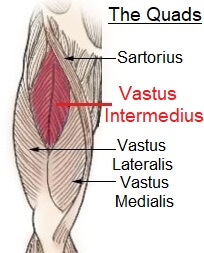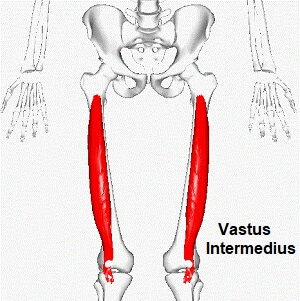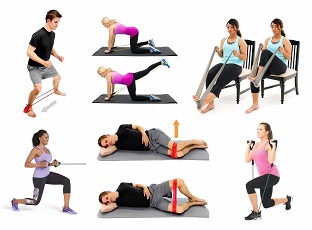- Home
- Knee Joint Anatomy
- Knee Muscles
- Quadriceps
- Vastus Intermedius
Vastus Intermedius
Written By: Chloe Wilson, BSc(Hons) Physiotherapy
Reviewed by: KPE Medical Review Board
Vastus Intermedius is the deepest of the four quadriceps muscles, which work together to straighten the knee.
It plays a significant role in stepping activities such as climbing stairs, as well as in squatting down.
Vastus intermedius down the front of the thigh, in-between vastus medialis and vastus lateralis, and underneath rectus femoris.
It is the hardest of the quads muscles muscles to stretch due to it positioning.
Origin & Insertion
Vastus Intermedius arises from fleshy fibres from the upper two-thirds of the anterior and lateral surfaces of the shaft of the femur.

The fibres run downwards forming a broad tendon on the more superficial aspect (known as a superficial aponeurosis) which attaches to the deep surface of rectus femoris, vastus lateralis and vastus medialis forming the deep part of the quadriceps tendon.
The quadriceps tendon attaches to the upper surface of the patella (kneecap), encompasses the patella and attaches to the tibial tuberosity via the ligamentum patellae.
Vastus Intermedialis is difficult to separate from vastus lateralis in the middle of the thigh and is frequently continuous with vastus medialis lower down, virtually impossible to separate.
Some of the deeper fibres of vastus intermedius attach to the superior aspect of the suprapatellar bursa which lies underneath the muscle. These fibres are referred to as the articularis genus, and arise from a small area on the lower third of the anterior femoral shaft, passing downwards to the bursa.
Vastus Intermedius is the hardest of the quadriceps muscles to stretch due to its position as the deepest and most central muscle. The other quadriceps muscles can be stretched by adding some bias to the stretch – rectus femoris by extending the hip and vastus lateralis and medialis by adding a sideways element to the stretch, usually through massage - vastus intermedialis is too deep to manipulate.
Function Of Vastus Intermedius
Vastus intermedius works with the other three quadriceps muscles to extend the knee and plays an important role in stepping activities e.g. stepping over objects and climbing stairs, as well as with squatting.
The main function of the articularis genus is to stop the synovial membrane from becoming trapped and interfering with normal knee movement.
Common Problems
The most common problems associated with vastus intermedius are:
- Muscle Tightness: Tightness in vastus intermedius can irritate the underlying supra patellar bursa, resulting in knee bursitis
- Muscle Strain: Over-stretching or overloading of vastus intermedius can cause a quads strain
- Muscle Weakness: weakness in vastus medialis can affect knee movement and function, resulting in anterior knee pain
If you have knee pain from a problem with vastus intermedius have a look at:
- Knee Muscles: Find out more about the muscles that control the knee, how they work and what can go wrong, including the other quadriceps muscles
- Quads Stretches: Includes simple tests to see if your muscles are tight and some great stretches to improve flexibility
- Quads Strengthening: Simple exercises to strength vastus intermedius and the other quads muscles
- Knee Strengthening Exercises: A whole range of exercises to strengthen all of the different knee muscles, ranging from beginners to advanced
Summary
Muscle Group: Vastus Intermedius is the deepest of the Quadriceps
Action: Straightens the knee (extension)
Origin: Anterior and lateral surfaces of the femoral shaft and lower part of the lateral intermuscular septum
Insertion: Attaches to the deep surface of the other quadriceps tendon, the base of the patella, suprapatellar bursa and the tibia via the patella tendon
Nerve Supply: Femoral nerve (L2, L3, L4)
Functional Activities: Stepping activities such as climbing stairs and squatting
AKA: Vastus Intermedialis
Other Knee Muscles
Page Last Updated: 11/23/21
Next Review Due: 11/23/23
Related Articles
Resistance Band Exs
December 7, 2023
Diagnosis Chart
March 25, 2025
Knee Pain On Stairs
January 16, 2023






